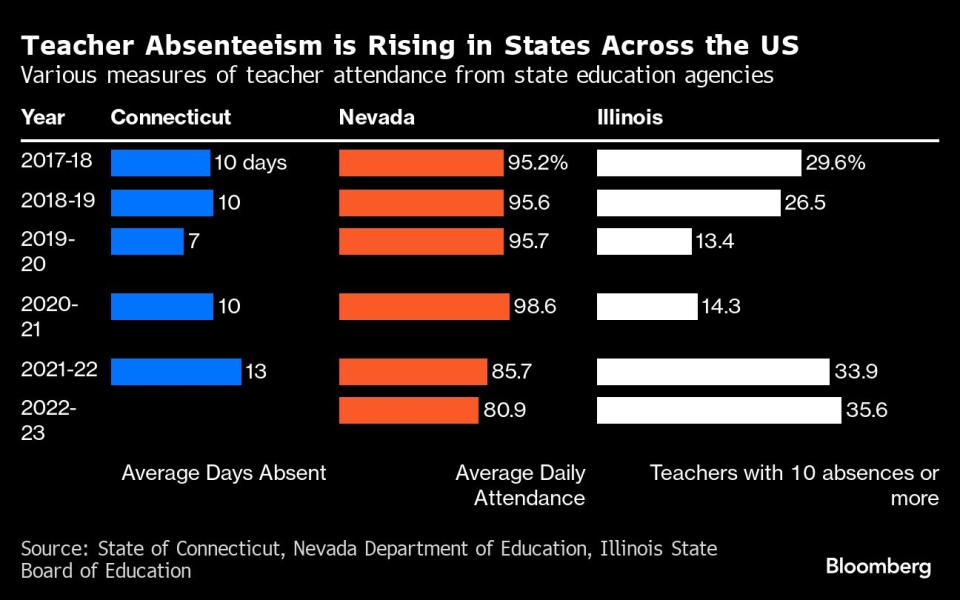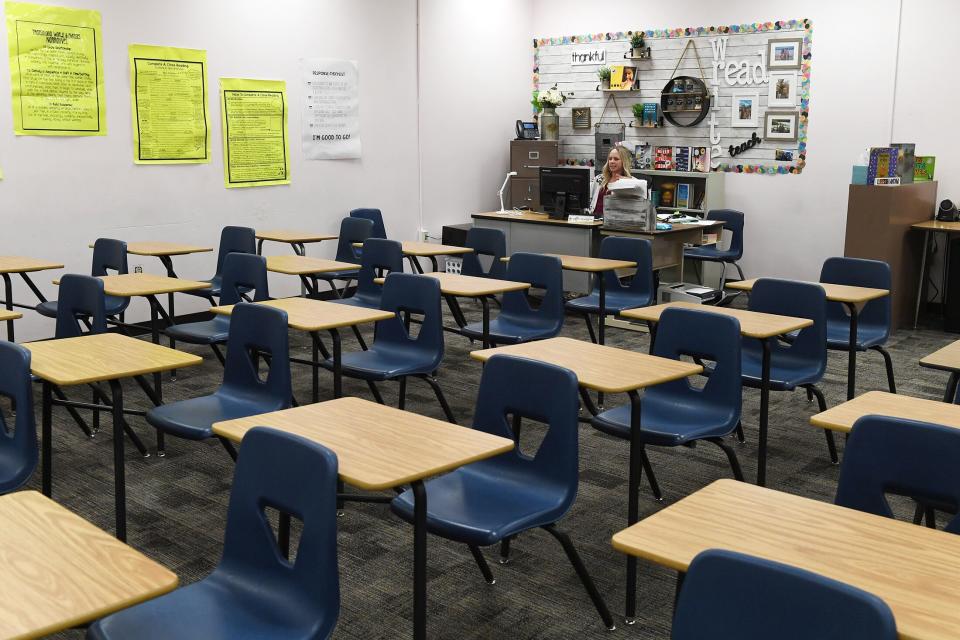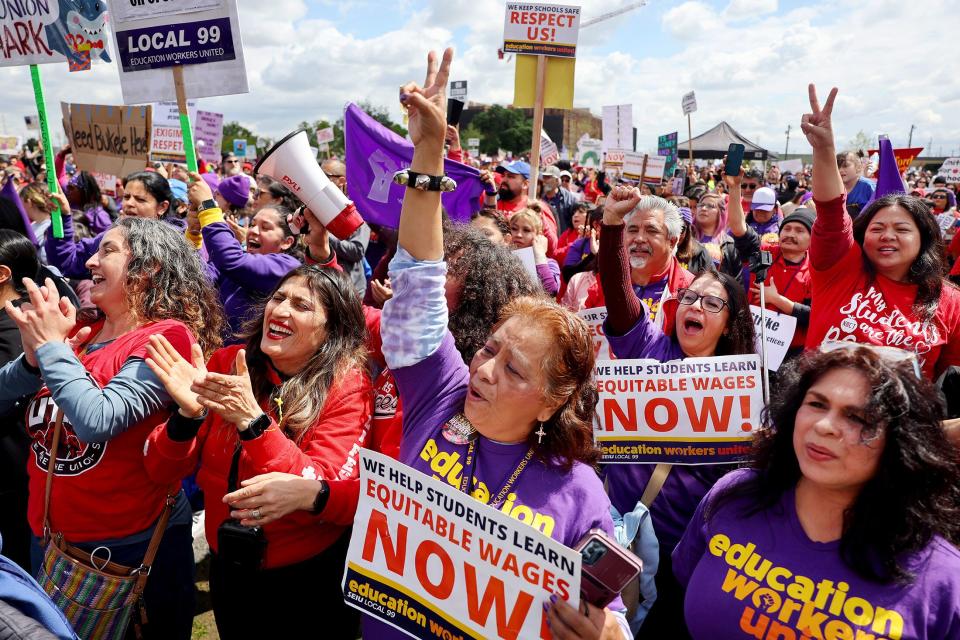Absent Teachers Risk Costing American Schools $4 Billion a Year
(Bloomberg) -- Las Vegas sits in one of the nation’s largest school districts that employs a small army of teachers - over 17,000 positions. On an average day last year, nearly a quarter of them weren’t in class.
Most Read from Bloomberg
Real Estate Investors Are Wiped Out in Bets Fueled by Wall Street Loans
Billionaire-Friendly Modi Humbled by Indians Who Make $4 a Day
A Struggling Business Park Deals a Blow to Singapore's Regional Hub Ambitions
Since returning from virtual education during the pandemic, teacher attendance in Clark County, and statewide, has sunk to the lowest in more than a decade, according to data from the Nevada Department of Education. It’s a problem that’s worsened across the country, from East Coast school districts in New York and Connecticut to Chicago. On any given day, as many as 10% of teachers don’t make it into the classroom, according to staffing firm Kelly Services Inc., citing its data from 40 states. That’s up from 6% during the Covid pandemic.
Now, with schools still struggling to make up for the education lost during the lockdowns, officials are facing a growing economic burden that will be compounded when federal stimulus funding ends in September. If even 8% of the nation’s 3.2 million full-time public school teachers call out, that conservatively amounts to a daily cost of roughly $25.6 million for districts, or $4.4 billion per school year, according to Bloomberg estimates.
“We hear from financial leaders that they’re worried about it, the cost can be from $100 to $250 a day for a sub,” said Marguerite Roza, director of the Edunomics Lab at Georgetown University. “If students who missed a year of learning are now missing 10% because of chronic absence, and another 10% because their teacher is chronically absent, they are never going to get back on track.”
School leaders and teachers say the troubling trend is a symptom of the profession’s growing challenges: difficult work environments with more student behavioral issues, fewer resources, and low salaries eaten away by inflation. And the pipeline is smaller with fewer people earning an education degree.
Before the pandemic, teachers had overall average attendance rates of 95%, and a typical educator missed about nine days out of 187 in the school year, according to a survey of the 30 biggest districts conducted by the National Council on Teacher Quality. The share of chronically absent teachers was declining and those with “excellent” attendance, missing three days or fewer, was rising. The council, which released the results in 2020, defined chronically absent as missing 18 days or more.
But among a small group, absenteeism was rampant: 1 out of 10 teachers missed an average of 22 days of work, accounting for a quarter of all absences nationwide. And it has since gotten worse.
More recent federal data shows most schools saw teacher absentee rates higher than they were before the pandemic, with nearly three-quarters of public schools reporting an increase during the 2021-22 school year, according to Department of Education survey results released in 2022.
Sparse Data
Nevada is one of the few states that even tracks teacher attendance. Of the 10 largest states, at least six don’t collect district data on teacher attendance. Among states that do, data shows teachers are calling out more often.
Post-pandemic, there’s been a global shift in views on the use of sick time, according to a spokesperson for the Clark County School District. The district’s 76% average daily teacher attendance rate during the 2022-23 school year also includes unfilled positions, the spokesperson said in an emailed response to questions. The district already has about 92% of all licensed positions filled for the 2024-25 school year.
Research has shown student outcomes drop when teachers are absent 10 days or more. In Connecticut, classroom teachers missed 13 days on average in the 2021-22 school year. Over 20 districts reported averages of 15 days or more, according to state data. The stakes are high: more than half of Connecticut students are below grade level proficiency in math, and the achievement gap between poor and wealthy students is widening.
Matthew Cerrone, a spokesperson for the Connecticut State Department of Education, said rising absences are likely tied to a complex range of factors, and department officials are investigating the issue, which dovetails with recruitment and teacher shortages.
In New York City, the nation’s largest school district, about one in five public school teachers missed 11 days or more during the 2022-23 school year, an increase from 13% four years prior. About 43% of Chicago teachers were absent 10 or more times in 2023, the highest share since at least 2018. The trend was the same across the state, according to data from the Illinois State Board of Education.
Last year, Illinois Governor J.B. Pritzker and lawmakers appropriated $45 million for a grant program for schools facing the worst teacher shortages. Recipients have used funds to invest in retention incentives like loan forgiveness, as well as programs to improve school culture and support staffing, according to Jackie Matthews, a spokesperson for the state board of education.
A district about 200 miles (322 kilometers) southwest of Chicago received a $400,000 grant as part of the program. Galesburg CUSD #205 and its 3,900 students had about 20 long-term, unlicensed substitutes in classrooms.
The state funds have helped, according to Mindi Ritchie, assistant superintendent of human resources and student supports. They funded a staff wellness day and helped finance programs like loan reimbursement and long-term sub credentialing.
‘Striking Increase’
California does not track teacher attendance at the state level, and Los Angeles Unified School District, the second-largest in the country, didn’t provide records of the data in response to a Bloomberg News public information request. But teachers in the district have noticed a change.
“Since the pandemic, there’s been a really striking increase in both student absenteeism and teacher absenteeism,” said Noriko Nakada, a veteran middle school teacher in LAUSD. She said understaffing at her school has forced others to cover for a math teacher vacancy that was open for most of this year. “That causes all the teachers to pickup the slack, and just makes all the teachers more susceptible to being sick or exhausted.”
To be sure, teachers are exposed to a gamut of germs in classrooms, and some research has shown that teachers actually take the same amount of absences, if not less, than similarly educated workers when demographics are controlled.
Low starting pay, burdensome student loans, attrition and a smaller teacher pipeline have exacerbated absences, especially long-term ones, as the stresses weigh on staff, driving some to leave and forcing those who remain to pick up extra work, said Nicola Soares, president of the education division at Kelly Services, the staffing firm.
A national shortage of substitute teachers makes it harder to get coverage. When subs aren’t available, teachers often give up free periods, or in extreme cases, students are corralled in a gym or cafeteria, or schools close entirely.
Teachers also say the job has become more mentally straining. Many grappled with an increase in behavioral outbursts from students returning from the pandemic, and schools have become an increasingly popular battleground for political culture wars ranging from book bans to transgender rights. In April, Tennessee Governor Bill Lee signed a law that would allow teachers to carry guns in schools a year after a shooter opened fire and killed three students and three staffers at a private Nashville school.
“The day to day operations are tiresome,” said Danette Stokes, a teacher and president of the local union chapter, the United Education Association of Shelby County in Tennessee. “A lot of teachers don’t get the support they need when it comes to discipline, we have to do what is best for us.”
Most Read from Bloomberg Businessweek
Sam Altman Was Bending the World to His Will Long Before OpenAI
David Sacks Tried the 2024 Alternatives. Now He’s All-In on Trump
Startup Brings New Hope to the Pursuit of Reviving Frozen Bodies
©2024 Bloomberg L.P.





